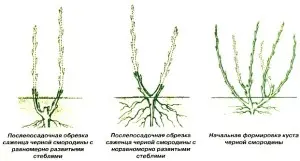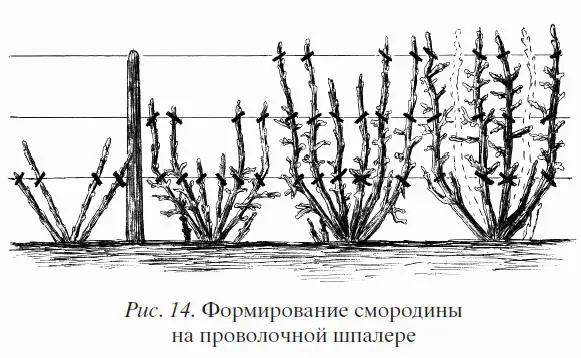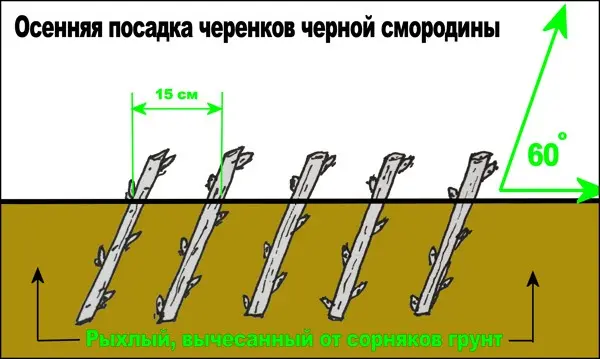Few summer cottages do without blackcurrant bushes. This is not only a green decoration and delicious berries, but also a source of a large amount of vitamins and minerals necessary for a full-fledged human life. Meanwhile, the cultivation and care of blackcurrant does not require much effort and expense, the main thing is to choose the right place for planting.
Blackcurrant planting technique
Currants can be planted both in early spring before bud break, and in autumn at the end of September. Planting time is not critical for growing and caring for blackcurrants. For 3-4 weeks, before planting the bushes, it is necessary to prepare planting pits and fertilize the soil. The site is deeply dug up, the rhizomes of perennial weeds and other debris are removed, and fertilizers are evenly scattered per 1 sq. M. 4-5 kg of rotted compost or humus, 20-30 g of potassium sulfate and superphosphates. Planting pits are not made very deep 30-40 cm and 40-45 cm wide, placing them according to the scheme 1,5-1,7 m distance between the bushes and 1,8-2,2 m between the rows.

6-7 kg of humus, 15-25 g of superphosphate and potassium sulfate mixed with fertile soil are added to the bottom of each pit. If the soil is clayey and depleted, planting pits are made deeper 50-65 cm and 55-65 cm in diameter, while leaving a fertile layer, and the deep one is removed. Also, coarse-grained river sand is added to ensure good drainage. When planting and caring for blackcurrants in autumn, 250-350 g of wood ash, 30-35 g of potassium sulfate and superphosphates or 50-60 g of Agricola are added under each seedling. When planting is carried out in the spring, an increased amount of 10-12 kg of humus and 60-80 g of liquid fast-acting complex fertilizers, such as Ross or Effecton, are added to each pit.

The pit is filled with an earthen mixture with fertilizers. They dig to the depth of the bayonet, supplement it with fertile soil from above and pour it abundantly with water. Seedlings are planted after 3-6 days, deepening them by 10-13 cm. Immediately before planting, the seedlings are cut, leaving 3-5 well-developed buds. The root system should be well branched, not damaged and not dried. The roots are straightened in different directions, falling asleep with earth, gently shaken several times and watered with a small amount of water. The soil around the bushes is compacted with their feet and mulched with peat or straw. Sawdust is not used as a mulching material, in order to avoid excessive acidification of the soil. For the compact formation of bushes and to ensure proper care for blackcurrants in the future, they are planted vertically. You can plant currants obliquely to form new shoots and additional roots. At the same time, the root collar is buried 7-9 cm below the soil level.

Basic aspects of care
Black currants grow and fruit best in light, moist, fertile, neutral or alkaline soils with good drainage. If the earth is highly acidic, it should be subjected to liming. With proper care, blackcurrant will grow well in a shaded place, but it is better for her to choose an open, illuminated area. The ideal option is a small artificial hillock of fertilized and inverted sod, in a sunny place, protected from strong winds.
Blackcurrant care includes regular loosening of the root zone throughout the season, removal of weeds. Every year in early spring in April or late autumn, rejuvenating pruning of bushes is carried out, cutting out old, diseased, damaged, low-bearing branches. During the growing season, bud break is monitored. If they swell, but do not open, then they are affected by a tick, they should be removed if there are no more than 2-3 affected buds on the branch, if more, the entire branch must be removed and burned. In the summer, branches without berries and with double leaves should be cut.

Bushes need regular, but not plentiful watering, as in hot weather, currants shed their leaves very quickly. Rain watering has a beneficial effect on productivity. During the season, adult bushes are treated 2-3 times with a 1-2% solution of copper sulfate or Bordeaux mixture. Although the currant is a crop resistant to various pests, it is advisable to treat with antiparasitic drugs in early spring.
It is necessary to plant several bushes side by side, in which case pollination will occur more efficiently and even self-fertile varieties will bear fruit better.
Video “Blackcurrant planting and care”
This video shows how to choose the right seedlings, what you should pay attention to; what is the peculiarity of blackcurrant care; how to carry out spring pruning; when and how to feed the bushes for a large and regular harvest.









